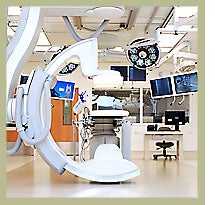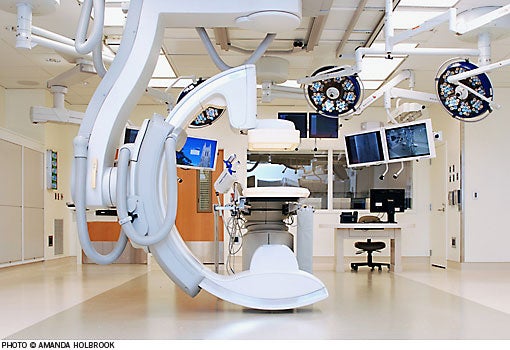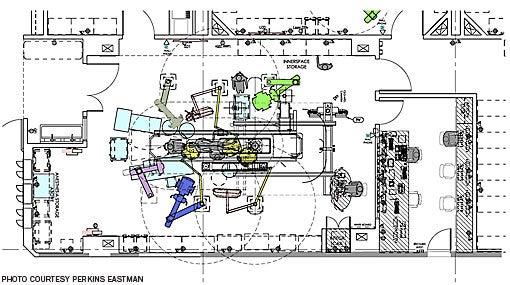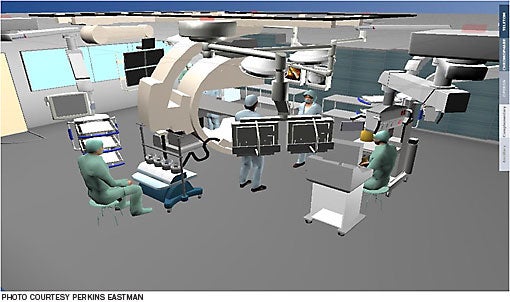Two in one
 From electronic records to angiography, advanced technology is rapidly changing the way medicine is practiced — not least in the surgical suite. At the vanguard of medical technological innovation are hybrid operating rooms (ORs) where state-of-the-art diagnostic imaging equipment is permanently integrated into the operating room.
From electronic records to angiography, advanced technology is rapidly changing the way medicine is practiced — not least in the surgical suite. At the vanguard of medical technological innovation are hybrid operating rooms (ORs) where state-of-the-art diagnostic imaging equipment is permanently integrated into the operating room.
Combining technology that's traditionally housed in the radiology center of a hospital with the operating room is transforming surgical care. For the first time surgeons can collaborate with pathologists and radiologists during surgery and make assessments using real-time or instantaneous images. It allows surgeons to immediately follow a diagnostic procedure with a therapeutic one. This configuration is also advantageous for surgery patients requiring more than one procedure discipline such as vascular and cardiac during one session.
It's not surprising, then, that hybrid ORs are often the preferred surgical suite configuration among surgeons. In fact, of 335 cardiac surgeons surveyed in 2009 by Steris Corp., 75 percent said they would like a hybrid suite in their hospital. Having a hybrid OR is becoming a standard requirement for leading new and renovated hospitals also because they can serve dual functions.
"A big attraction for hospitals is that they're highly flexible," says Jeffrey Brand, chief health care planner for Perkins Eastman's New York office, who has designed a number of hybrid ORs. "You can use them as a combined cardiovascular and surgical suite or else swing all the specialized imaging equipment aside and use it as a general operating room."
New breed, new challenges
The hybrid operating suite must be flawlessly planned and designed to function properly. A design team comprised of a collaborative group of architects, engineers, equipment planners, and consultants specializing in acoustics, vibration and audiovisual design and integration works in conjunction with a hospital team representing the composition of medical and technical staff who will be using the hybrid OR.
Just as with any hybrid, it's a new breed where the orchestration of teams, workflow, protocols, equipment and space present a new set of challenges. Additionally, the melding of the two distinct functions of radiology and surgery into one OR presents a new mix of physical requirements. For example the sterile and highly flexible environment of a surgical suite must accommodate the large footprints, considerable weight and rigorous stability specifications of radiology lab equipment. Connectivity is also an issue impacting the technological infrastructure. Will the surgical team use the OR to consult with medical staff on site or remotely? Will video feeds from hybrid OR procedures be transmitted to teaching or meeting rooms?
 |
| Caption: Duke University Medical Center's hybrid operating room. |
To get answers to these questions, the design team begins with a thorough needs assessment with input from the spectrum of potential users — the different surgeons, radiologists, anesthesiologists, nurses and technicians. From this phase, the space designers learn what kinds of procedures will be conducted, the surgical and imaging and technological equipment required, the number of medical staff present for procedures and any kind of connectivity desired with other spaces either within the hospital or remotely.
Space design planning
Hospitals will want to maximize the advantages of the hybrid OR's highly-integrated technology, such as the potential to record procedures and transmit images in real-time. Advance planning for related spaces such as a teaching theater or meeting rooms with live monitor feeds is important.
You may also like |
| Planning for hybrid operating rooms |
| Adding PET/MR systems to imaging |
| A review of imaging design guidelines |
| |
In identifying space, hospitals — especially those under renovation — must consider that the hybrid suite itself is 1,000 square feet or more, in some cases twice the size of a traditional OR. It is also important to consider where within the hospital the hybrid OR will be located to meet both structural and adjacency requirements. For example, it is critical to locate the hybrid OR away from high-vibration areas, such as mechanical rooms, to avoid having to provide supplementary reinforcement and vibration isolation for sensitive imaging technology. In some cases, the acoustical consultant will advise design teams to increase structural stiffness and change the vibration characteristics of the building itself. Floor layouts may also need to be adjusted to remove any adjacencies that could cause excessive vibration and changing floor types to minimize vibrations from rolling carts, for example, may be recommended.
In the hybrid OR, typical surgical equipment such as tables, lights, anesthesia machines and supply carts, are collocated with highly complex and space-hogging angiography equipment. Depending on what diagnostic procedure and imaging modality the hybrid OR is designed for, this equipment may include a CT scanner, Cath Lab equipment, or even an MRI, in addition to a bay of flat screen panels, equipment control area — all which must be kept safely out of the pathway of surgeons and nurses.
 |
| Caption: The choreograph plan for Duke's hybrid operating room. |
"In a very tight space, you'll have surgical lights, gantries holding imaging equipment, medical columns for anesthesia, and flat screens," says Brand. "It's a choreographic dance so they can all live together at the same time."
To help choreograph both the equipment and the medical and technical staff's workflow, the design team employs a number of visual tools. 3-D modeling and animated fly-throughs can help to visualize and analyze the physical topography of the room with all of the equipment in place. Actual size mock-ups of a hybrid OR, with the hospital's anticipated equipment selection installed, allow the surgical and radiology teams to truly "kick the tires." They enable the medical staff to see how all the elements in the space — people and machines — will interact. Hospitals should seek out architects and equipment and A/V integration vendors who are willing and capable of offering this mock-up service in advance of approval of any proposed room design plans.
Minimizing vibrations
Designs for even the bulkiest imaging equipment are quickly evolving for improved workflow and flexibility in the OR, but they come with structural and vibration isolation challenges. One system, for example, comprises two operating rooms with a shared MRI in the middle that rolls on ceiling tracks into either room for real-time three-dimensional imaging before, during and after surgery. MRI's and other advanced imaging systems demand impeccable stability, yet conditions in an operating room—multiple technical equipment and teams, for example—can increase vibration.
Whether ceiling or floor mounted, sensitive imaging equipment requires the architect, engineer and acoustical consultant to work together for proper support, reinforcement and vibration isolation. The structure is first tested to determine the need for isolation and further reinforcement. Once the equipment is installed in the hybrid OR, an acoustical consultant is required for further vibration testing and potentially corrective reinforcement and isolation. This final step in ensuring that the sensitive imaging equipment will perform to specification is crucial.
 |
| Caption: A 3-D optimization diagram for Duke's hybrid operating room. |
With ceiling mounted equipment, acoustic consultants may custom design isolation strategies that will fit within the ceiling. The horizontal rails holding ceiling-mounted angiography will often require strengthening via vertical supports and additional braces above the ceiling. For Perkins Eastman's hybrid OR at Duke University Medical Center, the firm used a grid-type system with additional bracing to hold the ceiling mounted medical columns and the rails for the angiography equipment. This was supported from the concrete deck and beams above the operating room.
The OR is already a noisy space replete with hard surfaces, but the hybrid OR — with its influx of technology and people — can increase the volume. Acoustical consultants can recommend strategies for mitigating noise, such as quieting HVAC noise through the duct and system design, isolating equipment noise and even lowering the volume of alarms and audio alerts.
Cabling and digital integration
Hospitals are often data rich, but information poor in that access to the data is not convenient. The trend towards digital integration along with the evolution of electronic systems for health care is changing that. Hybrid ORs in particular are highly integrated technological spaces. Not only do they offer surgeons immediate and live high-definition imaging, but they often include audiovisual components such as cameras for still and streaming images, along with monitors and microphones for telemedicine procedures, remote consultations, real-time conferencing, teaching, and documenting. Touch screens in the OR can also provide surgeons and nurses with access to patient records, giving them vital historical knowledge at their fingertips when responding to unanticipated situations.
The technical needs and workflow of the teams are key in determining the room's conduit design. It has to account for the location and number of monitors — at least six is not uncommon — and how the OR is connected to other areas of the hospital and remote sites. Designing consistent technological platforms and using forethought in cabling infrastructure ensures these networks will function effectively. Given the bandwidth demands of the hybrid OR's equipment, fiber optic cabling is becoming standard. Even "dark fiber," is highly recommended, where fiber optic cabling is laid in anticipation of equipment or a functionality not yet specified, available or even invented at the time the room is planned. After installation, the audiovisual consultants provide final onsite training for clinical and support personnel as well as maintenance training for staff engineers.
Planning is essential
The advantages of hybrid ORs are myriad, enabling combined procedures previously not possible. With more accurate and fewer procedures, patient recovery may be faster; corrective surgeries can be avoided; and given the potential for less risk, some patients formerly deemed inoperable can undergo procedures in a hybrid OR. For hospitals the combination of several procedures into one allows for better use of staff as well as the reduction of patient transportation, set up time, and space needs. But given the immense complexities and multiple factors determining the success of a hybrid OR, advanced planning is essential. It's what enables the medical staff and technology to function at their optimum level and in turn take healthcare to new heights.
James Perry is a health care specialist at Cerami & Associates, an acoustic, audiovisual, and technology design consulting firm. He can be reached at jperry@ceramiassociates.com. Allan Katz is CEO, president, and Founder of VTS Medical Systems, a firm that develops and integrates enabling technology for the healthcare industry. He can be reached at akatz@vtsmedical.com.




